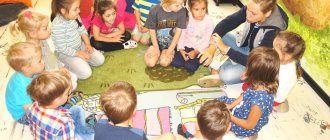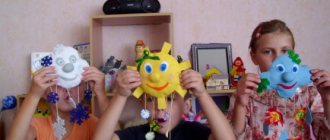Card file “Breathing gymnastics” (second junior group)
Tatyana Kostyukova
Card file “Breathing gymnastics” (second junior group)
Breathing exercises “Swing”
Goal: strengthen physiological breathing in children .
For a child in a lying position, a light toy is placed on his stomach in the diaphragm area. Inhale and exhale through the nose. The adult says the rhyme:
Swing up (inhale,
Swing down (exhale,
Hold on tight, my friend.
Breathing exercises “Tree in the wind”
Goal: formation of a breathing apparatus .
IP: sitting on the floor, legs crossed (options: sitting on your knees or on your heels, legs together)
. The back is straight. Raise your arms up above your head with an inhalation and lower them down to the floor in front of you with an exhalation, while bending your torso slightly, as if bending a tree.
Breathing exercises “Lumberjack”
Goal: development of smooth, long exhalation.
Stand straight with your feet slightly wider than shoulder-width apart. As you inhale, fold your hands like a hatchet and lift them up. Sharply, as if under the weight of an ax, lower your outstretched arms down as you exhale, tilt your body, allowing your hands to “cut through” the space between your legs. Say "bang." Repeat with your child six to eight times.
Breathing exercises “Angry hedgehog”
Goal: development of smooth, long exhalation.
Stand with your feet shoulder-width apart. Imagine how a hedgehog curls up into a ball when in danger. Bend down as low as possible without lifting your heels from the floor, clasp your chest with your hands, lower your head, exhaling “p-f-f” - the sound made by an angry hedgehog, then “f-r-r” - and this is a satisfied hedgehog. Repeat with your child three to five times.
Breathing exercises “Blow up the balloon”
Goal: train the strength of inhalation and exhalation.
IP: the child is sitting or standing. "Blowing up the balloon"
spreads his arms wide to the sides and
inhales , then slowly brings his hands together, bringing his palms together in front of his chest and blows out air - pfft. “The balloon burst”
- clap your hands,
“air comes out of the balloon”
- the child says:
“shhh”
, stretching out his lips with his proboscis, lowering his hands and settling, like a balloon from which the air has been released.
Breathing exercises “Leaf fall”
Goal: development of smooth, long inhalation and exhalation.
Cut out various autumn leaves from colored paper and explain to your child what leaf fall is. Invite your child to blow on the leaves so that they fly. Along the way, you can tell which leaves fell from which tree.
Breathing exercises “Geese are flying”
Goal: strengthen physiological breathing in children .
Slow walking. When you inhale, raise your arms to the sides, when you exhale, lower them down, pronouncing a long sound “g-u-u-u”
.
Breathing exercises “Fluff”
Goal: formation of a breathing apparatus .
Tie a light feather to a string. Invite your child to blow on it. It is necessary to ensure that you inhale only through your nose, and exhale through pursed lips.
Breathing exercises “Beetle”
Goal: train the strength of inhalation and exhalation.
IP: the baby stands or sits with his arms crossed over his chest. He spreads his arms to the sides, raises his head - inhale, crosses his arms over his chest, lowers his head - exhale: “huh-uh-uh,” said the winged beetle, I’ll sit and buzz.”
.
Breathing exercises “Cockerel”
Goal: strengthen physiological breathing in children .
IP: standing straight, legs apart, arms down. Raise your arms to the sides (inhale, and then slap them on your thighs (exhale, say “ku-ka-re-ku”
.
Breathing exercises “Crow”
Goal: development of smooth, long exhalation.
IP: the child stands straight, legs slightly apart and arms down. Inhale - spreads your arms wide to the sides, like wings, slowly lowers your arms and exhales: “karrr”
, stretching the sound [p] as much as possible.
Breathing exercises “Locomotive”
Goal: formation of a breathing apparatus .
Walking, making alternating movements with your arms and saying: “chuh-chuh-chuh”
.
At certain intervals you can stop and say “too-too
. Duration – up to 30 seconds.
Breathing exercises “Grow Big”
Goal: development of smooth, long exhalation.
IP: standing straight, feet together. Raise your arms up, stretch well, rise on your toes – inhale, lower your arms down, lower your entire foot – exhale. As you exhale, say “u-h-h-h”
!
Repeat 4-5 times .
Breathing exercises “Clock”
Goal: strengthen physiological breathing in children .
IP: standing, legs slightly apart, arms lowered. Swinging your straight arms back and forth, say “tick-tock”
.
Repeat up to 10 times .
Breathing exercises “Porridge is boiling”
Goal: formation of a breathing apparatus .
IP: sitting, one hand lies on the stomach, the other on the chest. Drawing in the stomach and drawing air into the lungs - inhale, lowering the chest ( exhaling air )
and sticking out your stomach - exhale.
When exhaling, pronounce the sound “f-f-f-f”
.
Repeat 3-4 times .
Breathing exercises “Balloon”
Goal: strengthen physiological breathing in children .
IP: Lying on the floor, the child puts his hands on his stomach. Taking a slow, deep breath, inflates your stomach, while imagining that a balloon is inflating in your stomach. Holds your breath for 5 seconds . Exhales slowly, the stomach deflates. Holds your breath for 5 seconds . Performed 5 times in a row.
Breathing exercises “Pump”
Goal: strengthen physiological breathing in children .
The baby puts his hands on his belt, squats slightly - inhale, straightens up - exhale. Gradually the squats become lower, the inhalation and exhalation take longer. Repeat 3 – 4 times .
Breathing exercises “Regulator”
Goal: formation of a breathing apparatus .
Stand straight, feet shoulder-width apart, one arm raised up, the other to the side. Inhale through your nose, then change the position of your hands and during an extended exhalation say “r-r-r-r-r”
.
Repeat 5-6 times .
Breathing exercises “Scissors”
Goal: formation of a breathing apparatus .
I. p. - the same. Straight arms are extended forward or to the sides at shoulder level, palms facing down. With an inhalation, the left hand rises up, the right hand goes down. With an exhalation - left hand down, right hand up. After the child has mastered this exercise, you can change it: not the arms move from the shoulder, but only the hands.
Breathing exercises “Snowfall”
Goal: development of smooth, long inhalation and exhalation.
Make snowflakes from paper or cotton wool (loose lumps)
. Explain to the child what snowfall is and invite the child to blow “snowflakes” from the palm of his hand.
Breathing exercises “Trumpeter”
Goal: development of smooth, long exhalation.
IP: sitting, hands clenched into a tube, raised up. Exhale slowly while pronouncing the sound “p-f-f-f-f”
.
Repeat up to 5 times .
Breathing gymnastics “Duel”
Goal: strengthen physiological breathing in children .
Roll a piece of cotton wool into a ball. Gate - 2 cubes. The child blows on the “ball”, trying to “score a goal” - the cotton wool should be between the cubes. With a little practice, you can conduct competitions with one cotton ball on the principle of playing football.
Breathing exercises “Spring”
Goal: formation of a breathing apparatus .
IP: lying on your back; legs straight, arms along the body. Raise your legs and bend them at the knees, press them to your chest (exhale)
.
Return to IP (inhale)
.
Repeat 6-8 times .
Breathing exercises “Who will drive the ball further”
Goal: development of smooth, long exhalation.
Sit down at the table with your baby, place two cotton balls in front of you (multi-colored ones are easy to find in supermarkets, and white ones can be made from cotton wool yourself). Blow on the balls as hard as possible, trying to blow them off the table.
Breathing exercises “Blow on a dandelion”
Goal: train the strength of inhalation and exhalation.
IP: the baby is standing or sitting. He takes a deep breath through his nose, then exhales long through his mouth, as if he wants to blow the fluff off a dandelion.
Breathing exercises “Windmill”
Goal: development of smooth, long exhalation.
A child blows on the blades of a spinning toy or a windmill from a sand set.
Breathing exercises “Hippos”
Goal: train the strength of inhalation and exhalation.
IP: lying or sitting. The child places his palm on the diaphragm and breathes deeply. Inhalation and exhalation are done through the nose
The exercise can be performed in a sitting position and accompanied by rhyming:
The hippos sat down and touched their bellies.
Then the tummy rises (inhale,
Then the tummy drops (exhale)
.
Breathing exercises “Chicken”
Goal: development of smooth, long inhalation.
IP: the child stands straight, legs slightly apart, arms down, spreads his arms wide to the sides like wings - inhale; while exhaling, bends over, lowering his head and hanging his arms freely, pronouncing: “tah-tah-tah”
, while patting himself on the knees.
Breathing exercises “Soaring butterflies”
Goal: development of smooth, long exhalation.
Cut out butterflies from paper and hang them on threads. Invite the child to blow on the butterfly so that it flies (while making sure that the child makes a long, smooth exhalation)
.
Breathing exercises “Stork”
Goal: development of smooth, long exhalation.
Standing straight, spread your arms to the sides, and bend one leg forward. Hold the position for a few seconds. Keep your balance. As you exhale, lower your leg and arms, quietly saying “sh-sh-sh-sh.” Repeat with your child six to seven times.
Breathing exercises “In the forest”
Goal: to form correct speech breathing .
Imagine that you are lost in a dense forest. After inhaling, say “ay” as you exhale. Change your intonation and volume and turn left and right. Repeat with your child five to six times.
Breathing exercises “Wave”
Goal: train the strength of inhalation and exhalation.
IP: lying on the floor, legs together, hands at your sides. As you inhale, raise your arms above your head, touching the floor, and as you exhale, slowly return to their starting position. Simultaneously with the exhalation, the child says “Vni-i-i-z.” After the child masters this exercise, speaking is canceled.
Breathing exercises “Hamster”
Goal: development of smooth, long exhalation.
Invite your child to walk a few steps (up to 10-15, puffing out his cheeks like a hamster, then lightly slap himself on the cheeks - release the air from his mouth and walk a little more, breathing through his nose.
Breathing exercises “Little Frog”
Goal: to form correct speech breathing .
Place your feet together. Imagine how the little frog jumps quickly and sharply, and repeat his jumps : squatting slightly, inhaling, jump forward. When you land, “croak.” Repeat three to four times .
Breathing exercises “Indian War Cry”
Goal: to form correct speech breathing .
Invite your child to imitate the Indians' war cry: shout quietly, quickly covering and opening your mouth with your palm. This is a fun element for children that is easy to repeat . An adult can “control the volume”
, indicating alternately with your hand
“quieter-louder”
.
Breathing exercises “Pearl divers”
Goal: strengthen physiological breathing in children .
It is announced that a beautiful pearl lies on the seabed. Anyone who knows how to hold their breath . The child, in a standing position, takes two calm breaths and two calm exhalations through the nose, and with the third deep breath closes his mouth, pinches his nose with his fingers and squats until he wants to exhale.
Goals and objectives of breathing exercises for younger preschoolers
Breathing exercises are a set of exercises aimed at developing the respiratory system and articulation. At 2-3 years old, children often breathe through their mouths. This is facilitated by regular runny noses and problems with the adenoids, which adversely affects the tonsils, especially in the cold season.
Children
To avoid serious consequences, according to the program developed on the basis of the Federal State Educational Standards of preschool educational institutions, the following goals are set:
- developing the skill of breathing through the nose;
- prevention of influenza and ARVI;
- increased tone of the respiratory muscles;
- positive impact on performance;
- development of organs of articulation;
- formation of concepts about healthy lifestyle;
To meet the goals, clearly defined tasks are needed:
- development of respiratory control skills: control of the rhythm, depth and force of inhalation and exhalation;
- development of speech organs through breathing exercises with pronunciation of sounds;
- filling the body with oxygen;
- respiratory muscle training;
- prevention of the formation of adenoids, rhinitis, sinusitis;
- prevention of hypothermia of the respiratory system;
- developing teamwork skills.
On a note! Mastering goals and objectives will protect the child’s body from serious and chronic diseases.
For schoolchildren from 6 to 12 years old
At this age, we can perform with the child all the exercises already described earlier, and in addition, we add more complex exercises that we could not explain to the child while he is too young.
We smell the flower. It is better to start a cycle of breathing exercises with this exercise; it also teaches correct nasal breathing. You can perform it sitting, standing, lying down - in any position, but with one condition the back must be straight. You should take a deep breath through your nose, as if sniffing, that is, drawing in air through your nose. Exhalation also occurs through the nose - slowly and calmly. In total, you should take 3-4 such inhalations and exhalations.
Ask your child to listen to the sensations inside the nasal passages and try to describe them. Usually we are talking about tingling or tingling.
The fact is that the nasal mucosa is penetrated by many capillaries. When we slow down and intensify the process of air passing through the nose, and also focus our attention on it, we can feel how oxygen enters the blood directly through the mucous membranes of the nose. In a similar way, this happens inside the lungs, which are riddled with blood vessels.
It is believed that oxygen absorbed through the nose goes directly to the brain. That is why, with nasal congestion, rhinitis and other problems that impede the flow of air directly to the mucous membranes of the nose, the human brain suffers from oxygen deficiency. Knowledge of these facts and the very sensation of breathing through the nose can motivate the child to keep the nasal passages clean and avoid factors that provoke colds. In addition, the nasal mucosa is a kind of immunity center in the body. This means that active (and calm) conscious breathing through the nasal passages helps prevent many diseases and cope with their consequences.
Calm breathing. The exercise is also performed in any comfortable position and in a calm environment. It may turn out to be a little more difficult than it looks at first glance, so mastering it should be gradual. It can be most difficult for impressionable, easily excitable or anxious children, and it is for them that it will bring the greatest benefit.
You should inhale slowly until the chest expands, then take a short pause (hold your breath) and exhale smoothly. In total, you should do from five to ten such inhalations and exhalations. The only difficulty is that these actions should not cause any physical stress. Therefore, allow the child to independently determine the time of inhalation, retention and exhalation according to his feelings.
Hamster. In this exercise, the child, inhaling, inflates his cheeks with all his might (as in the “Bubbles” exercise described in the previous section). Then an inhalation is held, during which the cheeks remain tense. During this delay, several steps can be performed (the hamster drags supplies hidden behind its cheeks into its hole). A sharp exhalation occurs due to hitting the cheeks with your palms. After this, you should take several frequent breaths - the hamster sniffs the surrounding space. And then he goes again for supplies - inhale while puffing out his cheeks, hold, exhale sharply by slapping his cheeks, several quick breaths. You can repeat the exercise 3-4 times.
The combination of actions of different nature into one sequence (which is actually quite logical from a physiological point of view) helps to better master the art of controlling your breathing in its various aspects. Creating additional pressure inside the oronasal cavity, as mentioned above, helps to increase local immunity by eliminating congestion.
Fists. IP - standing, feet shoulder-width apart, arms extended forward. You should inhale not in one continuous breath, but in four steps - 4 short sharp breaths. At this time, the fists are clenched (during inhalation) and unclenched, as if helping the child control his breathing. Exhalation occurs arbitrarily, calmly, through the nose. This exercise improves not only the respiratory system, but also the nervous system.
Indian war cry. The exercise helps you master your voice, learn to speak sonorously, and control the volume and “flight” of your voice.
Performed in any position. The exercise itself is extremely simple: you should make a sound while rhythmically covering your mouth with your palm. Give your child the task of adjusting the volume of the cry. Let it make a sound, sometimes with greater or lesser volume.
Also explain that the voice should be mentally sent into the distance so that it sounds louder (instead of overstraining the ligaments), and give the baby the opportunity to practice and make sure of this.
Free lessons from experts
They will help you take the first step in creating a developing space for your child at home





